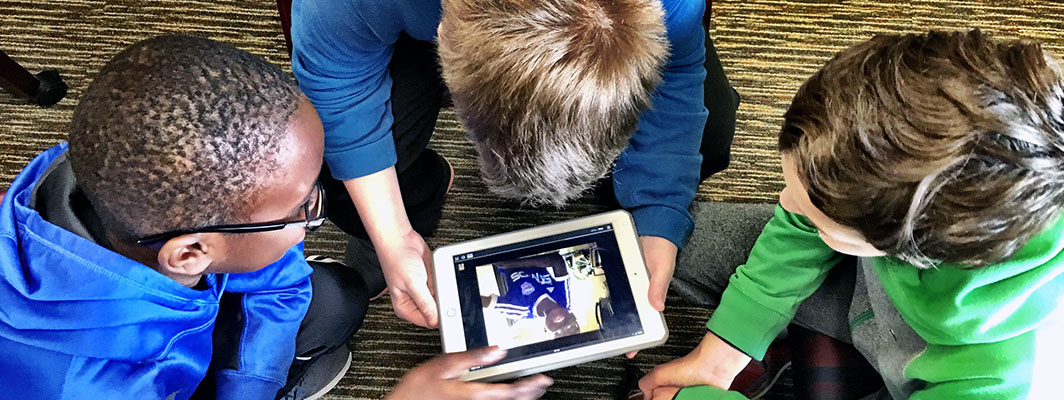
In their first year as Verizon Innovative Learning schools, Lassiter Middle School and W.E.B. DuBois Academy experienced tremendous growth on their Measures of Academic Progress (MAP) test scores. DuBois, in fact, had the highest percentage of growth for African-American male students in the entire district.
Lassiter and DuBois are two of 100 Verizon Innovative Learning schools around the country. Since 2014, the initiative—made possible by a partnership between Digital Promise and Verizon—has worked to bridge the Digital Learning Gap by equipping every student and teacher at these select middle schools with devices and up to a four-year data plan.
“I believe one of the largest contributors to our overall MAP growth and gains is the Verizon Innovative Learning schools [initiative],” said James Unger, Verizon Innovative Learning schools coach at Lassiter. “Not only do the iPads add to student learning, but throughout the year, teachers have begun to change their practice to integrate more and more technology and innovative lessons. This is seen in almost every classroom. I believe the technology and the change in pedagogy across the entire school have contributed to our increased scores.”
Teachers at both schools say an important factor in their growth is the students’ access to learning apps like IXL and Study Island, which have similar question types to the MAP test. In fact, Study Island links to a student’s MAP score and tells them where they are strong and what they need to work on. The ability to personalize learning for each student means teachers don’t have to slow the whole class down while waiting for one student to catch up, or worry about students becoming bored when they finish assignments early.
“If they finish what they’re doing during class, they can instantly go do IXL or Study Island,” said Lillian Wyatt, a math teacher at Lassiter. “This way they are continuously thinking about what we worked on and they don’t just leave it behind.”
“It’s difficult to teach students in a whole group because of their differing levels. You shoot for the middle, but you’re always going to miss somebody on either extreme,” added Mary Leslie, an English/language arts teacher at DuBois. “I’ve been able to do more teaching in smaller groups without having to figure out what to do with the other kids—with the apps, I’m able to allow kids to work at their own pace.”
Teachers appreciate that technology allows them to give instant feedback and even communicate with students outside of class time, thereby extending the classroom beyond the school walls.
“When their assignment is submitted to me, I can type in feedback, and I can send that assignment back to students for revision, even when I’m sitting on the couch at home,” Ms. Leslie said. “There are many times that I get assignments submitted on weekends, and there are times I’ve gotten messages late at night asking me to send an assignment back. That to me has made a huge difference, because they’re not waiting for me to grade every single paper.”
Furthermore, students no longer fall behind when they’re absent because they’re still able to get feedback from their teachers, connect with their classmates, and access their homework through their iPads. “I post a video for everything that we do, so if they’re absent, or maybe if a student isn’t understanding, I can tell them to go watch that video,” Ms. Wyatt explained. “Most of them are visual learners, so watching that video helps them more than me talking to them.”
Students growing up in the 21st century are adept at using technology to communicate with their friends, watch videos on YouTube, or search for information on the internet. Having 1-to-1 devices in the classroom allows them to use tools, collaborate, and learn in school they same way they do in their personal lives, which in turn increases student engagement.
“It’s led teachers to explore some innovative approaches,” said Lassiter Principal Jon Cesler. “We had a sixth grade social studies teacher, for example, using a podcast. Right there, that’s just a hook for kids. [Moreover,] it’s increased the level of engagement, and that level of engagement has [led to] more time on task with academic work and more practice, which has ultimately led to more growth.”
Mr. Cesler also emphasizes that apps like Google Classroom help teachers and students stay organized, as students can keep track of their assignments and their due dates. “That helps students to take ownership of their learning,” he said.
Not only has the technology increased student engagement, but it has also enabled teachers to try new things in their classrooms to better personalize learning for each of their students and resulted in gains on standardized tests. Teachers at both schools attribute their students’ growth on their MAP test scores to the Verizon Innovative Learning schools devices and the ability for students to have 24/7 access to the internet.
“We’re so thankful for the Verizon Innovative Learning schools initiative,” said DuBois Principal Robert Gunn. “It certainly has allowed us to reach further than just the classroom—we’re actually able to go into households to help our students out. It’s been a game-changer for us.”
Learn more about how the Verizon Innovative Learning schools initiative has impacted its member schools at verizon.digitalpromise.org.